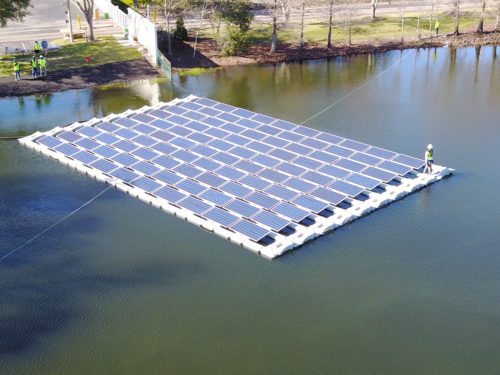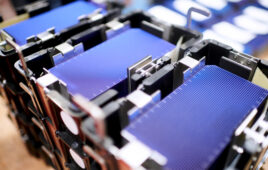Minnesota might be known as the Land of 10,000 Lakes, but Florida is pretty water-dense too. The state has 30,000 lakes spread across three million acres of land—most non-navigable. Florida is the third most populous state but only the 22nd largest state by area. People and unusable waterways are taking up a lot of space in the Sunshine State, leaving little room for significant solar projects.
That’s why floating solar—or floatovoltaics as it’s affectionately known—is a perfect fit for this watery, yet sunny state. The Orlando Utilities Commission (OUC) seems to understand this. Taking a look at an aerial map, the utility’s service area is peppered with a lot of blue. The Orlando International Airport looks like it’s trapped in the middle of a spider web of waterways. OUC knows that floating solar is its best option to bring more solar into its energy portfolio.
 So the utility pushed out a 31.5-kW floating array on one of its storm water storage reservoirs in February 2017. The project uses the expertise of French floatovoltaics godfather Ciel & Terre and newcomer installer D3Energy of Florida. Ciel & Terre, which manufactures the Hydrelio HDPE-floats that hold the panels and wires, has 60-MW of floating experience globally. This project is the first major floating array in Florida and one of only a handful in the United States.
So the utility pushed out a 31.5-kW floating array on one of its storm water storage reservoirs in February 2017. The project uses the expertise of French floatovoltaics godfather Ciel & Terre and newcomer installer D3Energy of Florida. Ciel & Terre, which manufactures the Hydrelio HDPE-floats that hold the panels and wires, has 60-MW of floating experience globally. This project is the first major floating array in Florida and one of only a handful in the United States.
“We were delighted to work with the Orlando Utilities Commission and D3Energy on this project,” said Eva Pauly-Bowles, international sales director of Ciel & Terre International. “This is the first stepping stone in our development of floating PV projects among public entities in the United States. D3Energy is an excellent local partner that has continued to be a great advocate for floating PV and continues to spread the word about our alternative to traditional ground-mount and rooftop systems.”
D3Energy, now exclusively working on floating projects, reached out to Ciel & Terre after CEO and president Lowell Dunn recognized the underutilization of the state’s bodies of water. With some previous construction experience and an entrepreneurial nature, Dunn wanted to do good for Mother Earth and partner with Ciel & Terre on floatovoltaics. D3Energy doesn’t plan to explore other more traditional solar projects.
“We think this is a very niche market,” Dunn said of floating solar. “Ciel & Terre is by far the Google of floating solar. They’re fabulous partners.”
 Representatives of OUC found D3Energy and Ciel & Terre after witnessing a small test project floated by University of Central Florida mechanical engineering students. In April 2016, the students assembled a 20-panel Ciel & Terre system on a retention pond, and the 5-kW project piqued the interest of OUC. Less than one year later, the utility had its own floating solar project.
Representatives of OUC found D3Energy and Ciel & Terre after witnessing a small test project floated by University of Central Florida mechanical engineering students. In April 2016, the students assembled a 20-panel Ciel & Terre system on a retention pond, and the 5-kW project piqued the interest of OUC. Less than one year later, the utility had its own floating solar project.
Dunn said floating solar has been slow to take off, but he’s hoping people will take it seriously after OUC’s 31.5-kW project.
“We’re working with several companies, but it’s always one of those, ‘We don’t really want to be first,’” he said. “This isn’t Ciel & Terre’s first rodeo.” On top of the 60 MW already installed globally, Ciel & Terre has 130 MW contracted for 2017—15 MW in the United States alone. And now with a manufacturing plant near Atlanta, Georgia, Ciel & Terre is producing Made-in-America Hydrelio systems, including those used in the Orlando project.
On this OUC project, Ciel & Terre was considered the EPC and its representatives helped teach D3Energy the installation basics. An assembly line of sorts was set up on land, and rows of Hydrelio floats and ReneSola panels were pushed into the water as they were connected.
“You assemble the floats, put the rails on, put the panels on,” Dunn said. “Then you put one row in the water and slide it out. You have three rows on shore at most and the rest is already floating. As you’re doing it, you’re wiring it from panel to panel to collector box to the floating transmission line to the inverter on shore.”
 One ABB inverter is housed on land. A marine-grade cable and chain anchors the floating array to the shore. Dunn said the anchor cable is slightly slack so the array can move around but not completely rotate. The Hydrelio system has been tested to withstand 130-mph winds.
One ABB inverter is housed on land. A marine-grade cable and chain anchors the floating array to the shore. Dunn said the anchor cable is slightly slack so the array can move around but not completely rotate. The Hydrelio system has been tested to withstand 130-mph winds.
Besides special cables and chains for anchoring, all other materials used on a floating array are the same as any land-based project. A floating array is never submerged and is designed to ride waves. The system experiences the same rain and moisture buildup as traditional arrays. Therefore, almost all major panel manufacturers can be used on floating solar systems.
“We are unbiased when it comes to panel selection, however we work mostly with trusted Tier 1 crystalline panel manufacturers,” Pauly-Bowles said. “The panels are never in direct contact with the water surface and benefit from being kept cooler due to the air and water exchange. Every panel manufacturer we have worked with is confident in providing the same warranty level as what you would get with a ground-mounted system.”
With this successful 31.5-kW installation, those at D3Energy are excited to squash any hesitation of being “the guinea pig” of a new installation technique in Florida. And they hope this is the first of many floating solar arrays in OUC’s service area.
“After completing the first successful Hydrelio floating PV power plant with OUC, we are now exploring the opportunity to deploy more large-scale floating PV systems with them,” Pauly-Bowles said.





Neat idea! Has anyone done this on a large scale?
Yes, in China. The 150 MW solar PV project has already been commissioned.
Apart from using “free” space, a large installation can reduce water evaporation, provide power to water treatment and storage facilities so a ready user is on hand. The natural heat dissipated could avoid water freezing in winter. I wonder how they avoid it becoming a landing station for birds…
Hello,
Yes, I was wondering price per watt also?
The firm I work for Hypower, is currently installing the Stanton Energy Center solar project. We’d love to build a project like this that is unique. We do a lot of utility scale ground mount but a floating project would be very neat.
Flotation introduces the opportunity for azimuth (single axis) tracking through a creative tethering arrangement.
What was the cost for the OUC SYSTEM?
I recommended a 1million solar panel installation 224mw to the city of vero beach and FPL to power 31,500 homes and now since the large oil tanks are removed near the water way we can begin construction